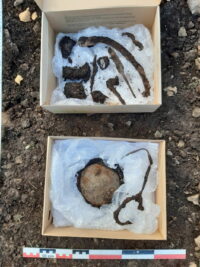 A richly furnished Viking grave has been unearthed in western Oslo, the first Viking-era grave replete with artifacts to be archaeologically excavated in the Norwegian capital.
A richly furnished Viking grave has been unearthed in western Oslo, the first Viking-era grave replete with artifacts to be archaeologically excavated in the Norwegian capital.
It was discovered on private property on a hill overlooking the Holmendammen pond. Plans to build a new home triggered an excavation of the site by the Oslo Municipality Cultural Heritage Management Office who uncovered the grave under a thin layer of topsoil.
The burial contained cremated human remains and a panoply of grave goods including fragments of a soapstone vessel, a penannular brooch, a sickle, two knives, horse tack that may have been a bridle and a bell and a shield boss. The metal boss would have been in the center of a wooden shield when it was first buried, but now the wood has all rotted away leaving only the shield boss.
The remains have not yet been radiocarbon dated, but the penannular brooch is of a type that were produced between 850 A.D. and the 11th century, mapping rather neatly with the Viking Age (800-1066 A.D.). The brooch is large of a type that was typically used to fasten men’s capes. The shield boss also points to the deceased having been an adult man.
[University of Oslo archaeologist Zanette Tsigaridas] Glørstad says this is the first artefact-rich Viking grave in Oslo that has been excavated by archaeologists. But many objects that can be linked to Viking graves have been found by, among others, construction workers in Oslo over the years.
Glørstad says that they are aware of the discovery of remains from around 60 graves from the Viking Age in Oslo. Most were found around the turn of the century in 1900 when the town expanded to St.Hanshaugen, Grünerløkka, Bjølsen, Tåsen and Sinsen.
These involve many individual items that can perhaps be connected to a grave, and in some cases they are found in a pile or together with burnt bones, says Glørstad.
The artifacts recovered from the grave are heavily corroded and are currently undergoing treatment and analysis in the conservation lab of the University of Oslo’s Museum of Cultural History. The cremated human remains are also being studied, but they were burned thoroughly so no DNA will be able to be extracted from the charred bone fragments.